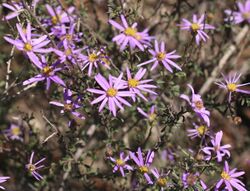Biology:Olearia humilis
| Olearia humilis | |
|---|---|

| |
| Near Mullewa | |
| Scientific classification | |
| Kingdom: | Plantae |
| Clade: | Tracheophytes |
| Clade: | Angiosperms |
| Clade: | Eudicots |
| Clade: | Asterids |
| Order: | Asterales |
| Family: | Asteraceae |
| Genus: | Olearia |
| Species: | O. humilis
|
| Binomial name | |
| Olearia humilis Lander[1]
| |
Olearia humilis is a species of flowering plant in the family Asteraceae and is endemic to the south-west of Western Australia. It is an erect, spindly shrub with narrowly egg-shaped or linear leaves, and purple and yellow, daisy-like inflorescences.
Description
Olearia humilis is an erect, spindly shrub that typically grows to a height of 0.4–1 m (1 ft 4 in–3 ft 3 in). Its stems and leaves are covered with scattered thread-like and glandular hairs. The leaves are arranged alternately along the branchlets, narrowly egg-shaped with the narrower end towards the base or linear and often curved, 20–30 mm (0.79–1.18 in) long, 1–3 mm (0.039–0.118 in) wide and sessile. The heads or daisy-like "flowers" are arranged singly on the ends of branchlets and are 15–30 mm (0.59–1.18 in) in diameter on a peduncle up to 40 mm (1.6 in) long. Each head has twenty to thirty purple or bluish-purple ray florets, the ligule 9.6–14.2 mm (0.38–0.56 in) long, surrounding a similar number of yellow disc florets. Flowering occurs from July to November and the fruit is a flattened, light brown achene, the pappus with 21 to 33 bristles.[2][3]
Taxonomy
Olearia humilis was first formally described in 1989 by Nicholas Sèan Lander in the journal Nuytsia from specimens collected by Philip Sydney Short, near the Sandstone-Paynes Find road in 1986.[2][4] The specific epithet (humilis) means "low" or "small", referring to the statue of this species.[2][5]
Distribution and habitat
Olearia humilis grows in shrubland and woodland in the Avon Wheatbelt, Coolgardie, Great Victoria Desert, Murchison and Yalgoo biogeographic regions of south-western Western Australia.[2][3]
Conservation status
This daisy bush is listed as "not threatened" by the Department of Biodiversity, Conservation and Attractions.[3]
References
- ↑ "Olearia humilis". Australian Plant Census. https://biodiversity.org.au/nsl/services/apc-format/display/104793.
- ↑ 2.0 2.1 2.2 2.3 Lander, Nicholas S. (1990). "Taxonomy of Olearia stuartii (Asteraceae:Astereae) and allied species.". Nuytsia 7 (1): 26–28. https://www.biodiversitylibrary.org/item/232338#page/32/mode/1up. Retrieved 27 April 2022.
- ↑ 3.0 3.1 3.2 "Olearia humilis". FloraBase. Western Australian Government Department of Parks and Wildlife. https://florabase.dpaw.wa.gov.au/browse/profile/12734.
- ↑ "Olearia humilis". https://biodiversity.org.au/nsl/services/rest/name/apni/533956/api/apni-format. Retrieved 27 April 2022.
- ↑ Sharr, Francis Aubi; George, Alex (2019). Western Australian Plant Names and Their Meanings (3rd ed.). Kardinya, WA: Four Gables Press. p. 220. ISBN 9780958034180.
Wikidata ☰ Q15586154 entry
 |

